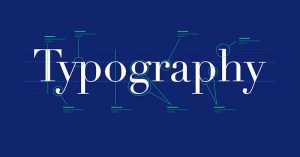Fonts are one of the most common and misunderstood tools of the digital world. Everyone uses them, and most people are familiar with a handful of the classics like Times New Roman and Arial. But few people ever think about where they come from—let alone the fact that someone had to sit down and craft each of those letters. And there is a reason for this: the trick of good font design is that they are meant to be useful in a variety of contexts, which means they should not draw attention to themselves and distract from the message.
How fonts work
Type design essentially involves going from your own handcrafted drawings of an entire alphabet to the development of a font file. As a type designer, your job is to take all of the erasures and corrections you made and lay them out in a way that is both aesthetically pleasing and readable. This is what we call the typographic process: from start to finish, we walk you through all the steps necessary to create a professional-looking font.
Step 1: Shape the letters
The first step in designing any typeface is to get familiar with your alphabet. When designing typefaces for print, you are usually limited to only Western Latin characters. It’s important that your fonts are accessible to non-Latin users, so it helps to know how many of these characters are necessary for most types of writing.
So, you take out your notebook and start to sketch. This is the easiest step in the process, once you’ve decided to be a type designer. Simply draw the letters right on your notebook. You don’t have to worry about line width or anything like that: shape and size are vastly more important than shape and size in this step. With practice, lettering begins to look natural and fluid: just like drawing letters with a pen or pencil
Step 2: Planning for print
Once you have done all your sketches, it’s time for planning. The shapes we drew were fluid and easy to draw—but they won’t work when we add in specifications like stroke widths. It’s up to you to decide how the letters will look when printed out in a document. This means that you need to decide whether your fonts are going to be serif, sans-serif, or a variation of the two. Serifs are the tiny horizontal lines that run across the bottom of letters like ‘q,’ ‘w’ and ‘j’. Sans-serifs have no serifs and will end with a rounder look.
Within each category, there is a range of styles. For example, a serif typeface may be more decorative and dramatic (such as those from the period between about 1770-1820) or more modern (from 1925 onwards). The choice you make will depend on the occasion and desired effect.
Step 3: Developing the font
The next step in designing a font is to create the actual files that are suitable for use. To do this, you have to get your drawing program to export straight into a form where you can load it up in your design software. There are two main categories of fonts for digital design—sans serif and serif. Each consists of its own set of challenges. Serif fonts have lots of strokes that need to connect together, making them harder to work with but creating more attractive results when they are done right. Sans-serif fonts are simpler shapes to work with, but are typically more difficult to read.
Step 4: Testing readability
One of the most important parts of designing a font is making it readable. On the computer screen, you have the luxury of being able to manipulate the typeface however you please. But in print, things can be very different. If your readers can’t tell what they are reading—or if it’s hard for them to read each letter—you’ve failed as a typographer no matter how beautifully your uppercase “I”s are shaped.
This step is all about making that final tweak that will take your font from looking good to reading well. It’s something that comes with practice, and there are a lot of tricks you can learn from other typesetters. The easiest way to do this is to use a typeface that is already in common use.
Step 5: Polishing your font for download
Finally, when your font is complete, you have to package it for download for all the people who want to use it! There are tons of programs out there for this, but the most important thing is making sure you have everything included in a neat and tidy format. It’s a lot of work, but if it’s going to be something that can pay you for the rest of your life, it’s a worthy profession.
That’s a quick rundown of how font design works. If you’re new to the craft or thinking about getting into it, now you know how it works from start to finish! With hard work and practice, anyone can design their own typeface—the most important thing is learning what makes for an appealing and readable font. Check back here often for more tips on typography and designing fonts as we continue our five-part series on font design.]
Interested in reading more about font design? Improve Your Website Through Typography discusses typography and how it can improve your website.
 If you would like to discuss Your Logo with Mojoe.net or your website’s analytics, custom logo designs, social media, website, web application, need custom programming, or IT consultant, please do not hesitate to call us at 864-859-9848 or you can email us at dwerne@mojoe.net.
If you would like to discuss Your Logo with Mojoe.net or your website’s analytics, custom logo designs, social media, website, web application, need custom programming, or IT consultant, please do not hesitate to call us at 864-859-9848 or you can email us at dwerne@mojoe.net.


Recent Comments